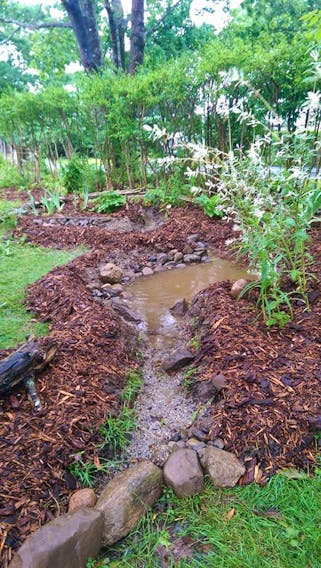It must be spring in Nova Scotia, because the rain is coming down. This is the time of year when we yearn for summer, easily forgetting the extreme heat and drought we often experience in the coming season. Sun and heat are good for our gardens, but associated drought creates stress for our plants.
‘Everything in moderation’ is a cliché for a reason. Water and heat can be both assets and challenges in our gardens, and truly great design works with nature on both fronts.
Rain gardens are designed to collect water, allowing it to infiltrate into the soil and water table. Rain gardens are typically designed to emulate the patterns of natural watercourses, such as creeks or ponds. Plants that thrive in wet environments do well in rain gardens. The system of plants roots and soil acts like a sponge, soaking up excess water for use in the system. This is good for people too, as it replenishes our drinking water in rural wells and municipal watersheds.
Rain gardens are an excellent way to bring nature into your garden. Freshwater is vital for all living things. Adding fresh water to your garden attracts all sorts of beneficial creatures, along with their pollination and soil-building services. Rain gardens are particularly attractive to amphibians such as frogs, toads and salamanders. Providing amphibian habitat is an important service because these sensitive creatures are in global decline. Of course, it is important to carefully consider existing animal patterns and tastes when planning your garden, because water may also attract deer and other forest creatures that will munch on favourite plants.
Rain gardens are ephemeral habitats, meaning that they change throughout the season. When it is rainy, the garden collects water that slowly drains into the soil. This constant water movement means that rain gardens are less attractive insect breeding grounds than standing water, such as ponds and puddles. The ephemeral nature of rain gardens also provides year-round benefits for the gardener because they always offer a new view to observe and enjoy.
Ready to create your own rain garden? Here are some helpful tips:
- Location, location, location. Your rain garden needs to be somewhere that is already wet and low-lying. Observe your landscape at different times in the season, especially after significant rain or snow melt. Notice the patterns of standing water and overland flow. Track your observations.
- Design with natural patterns. Consider existing water flow and the lay of the land in your garden location. Accentuate natural low-lying areas by digging swales, or trenches, 0.5-1.5 feet deep. Excess soil can be used to create berms, or small hills, at the edges of the swales. Swales can be left open, or filled with course rock materials, such as pea gravel or river rock. Berms can be amended to create garden beds for planting along the edges of the water-flow areas.
- Choose hardy, water-loving plants. It is important to choose the right plant for the right location. Of course, rain garden plants must be able to thrive in wet soil. However, they must also be hardy enough to resist drought, animal browse and minimal care. They must also be suited to the sun/ shade environment of your garden. I recommend including native plants that thrive in wetlands. Rain garden go-tos for our region include blue flag iris, sweet fern, jack-in-the-pulpit, willow, bayberry, red osier dogwood, red maple, black spruce, creeping juniper, Canada holly, native roses and sphagnum moss. Caring for plants that are already growing in the area will give you a head-start- they are already growing there, so you know they like the spot.
- Change is your friend. In the garden, as in life, change is the only constant. As gardeners, we must adapt to change in the landscape. Make sure you spend some time in your garden once it is created. Observe, take photos, meditate, do art, feed the birds or create little experiments. Being in your garden will allow you to notice change and feedback. Observations about plant health, creatures, water, erosion, and even your own patterns in the garden will help to inform future changes. The garden is a living system and is not static. Get in there, work with patterns and embrace changes.
Now - go garden!
Caitlin Doucette is a gardener and landscape designer based in Bridgewater. She is the owner of Earthshine Gardens, offering holistic ecological land care across the South Shore (www.earthshinegardens.com, [email protected], (902) 298-1205, @earthshinegardens).









